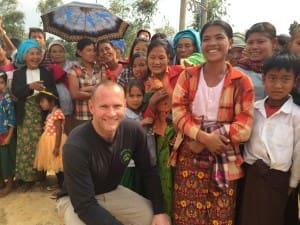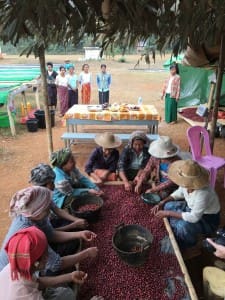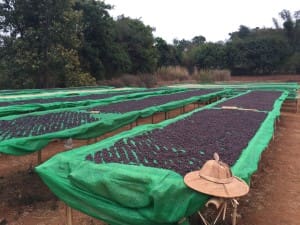You may have heard that there was a pretty amazing Myanmar cupping at SCAA this year, or that Atlas is bringing in some of these initial exports. Here's the story of the trips and cupping competitions leading up to the great advancements in this emerging origin. Atlas has been involved with the Myanmar Coffee Project since 2014 when Al Liu first visited to meet with coffee producers and help educate them about international markets. Since then Craig has made two additional visits focusing on assessing and improving quality and is on the ground there now overseeing the milling of our pending shipments.
In Myanmar, gold is very popular and important. The word shwe means gold, and it comes up a lot – in the names of buildings, temples, restaurants, and shrimp oil. And well it should - Myanmar is a wonderful place. The country itself is beautiful, and the people are warm, welcoming, and quick to laugh. After years of being very insular, Myanmar is looking outward once again, and the results, so far, are very encouraging. This renaissance extends to the coffee business.
Last February, my travels in Myanmar took me to the coffee growing regions in Mandalay and Shan State, and what I saw there was very encouraging. Just a year ago, I had judged a micro lot competition in Yangon. At the time, the average score was in the low seventies. Over the intervening months CQI implemented a training program with estates and smallholder farmers, focused specifically on harvesting, processing, and drying coffee. The results were amazing.
On this trip, we cupped 33 coffees, and the average score was up at least nine points. That’s a massive uptick in quality in just twelve months. It’s exciting to think what kinds of quality improvement the next years will bring.
A big part of that improvement is attributable to the approach growers have taken to the program. Both estate owners and smallholder farmers really embraced new ways of taking care of their coffee. With that kind of energy applied to coffee farms, anything is possible.
In Mandalay, we visited the mill and cupping lab run by the Myanmar Coffee Growers Association. This group of Estate holders has pooled their resources to help launch Myanmar coffee into the specialty market. Their cupping lab is top notch, and their mill and drying patios were so clean you could eat off the floor there. (I chose not to do so, however.) After an encouraging cupping of clean and bright washed process estate coffees, we visited several estates in and around Pyin Oo Lwin. At Sithar estate, Shwe Pu Zun estate, Blue Mountain estate, and and Green Land estate, we found meticulously well-organized farms, growing mostly S-795, SL 34, and Costa Rica varietals.
A particular challenge in Myanmar is the extreme weather. In the dry season it is scorchingly hot. In the rainy season they experience monsoon rains, and during the winter they sometimes get below freezing. To protect against the dramatic weather, growers pack their shade trees much tighter than almost any place I’ve seen before. The dominant shade tree is silver oak, the leaf drop of which provides valuable mulch. Another challenge for Myanmar coffee is the soil. Throughout most of the coffee growing areas there is a relatively thin layer of top soil which sits on a deep bed of magnesium. As a result, growers struggle to keep the right pH balance in their soil.
The upside of Myanmar’s crazy weather was evident when we headed over to Shan State, in the areas around Ywangan. We visited smallholder farmers in this region, and most of them produce natural process coffee. This works very well here, because the weather turns dry and very hot at the beginning of the harvest, which allows growers to dry their coffee at a good pace. The results were naturals with a good amount of dried berry character, but with the added intrigue of a unique rum raisin flavor that I have rarely encountered elsewhere.
We visited a number of communities, and in each place we found people picking the coffee at peak ripeness, and drying it on raised screens. Often, the drying beds were located close to the community temples, which are the center of any village. I took it as a clear indication of how important the coffee business is to these communities.
The estates and smallholder farms we visited on this go-round were all between about 1,150 and 1,400 masl. Though the elevations weren’t particularly high, the coffees showed good brisk acidity, and plenty of body. And while the washed coffees – as mentioned above – cupped similar to a good Central, the natural coffees came in somewhere between a top flight Brazil natural and a good natural Ethiopia.
Stay tunes for updates about these coffees! You can also learn more about Myanmar on the Atlas Myanmar page, and see more photos on Atlas' Flickr.


